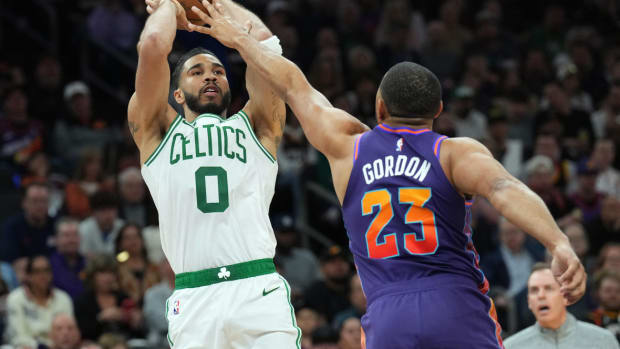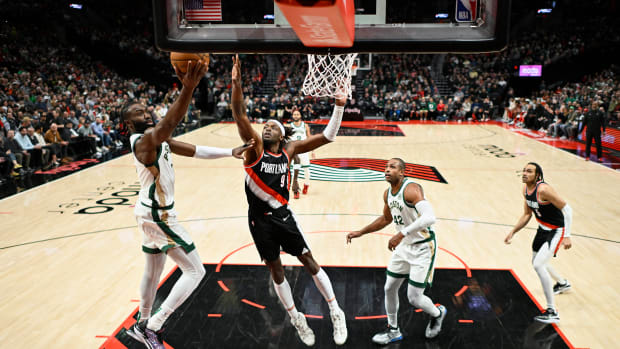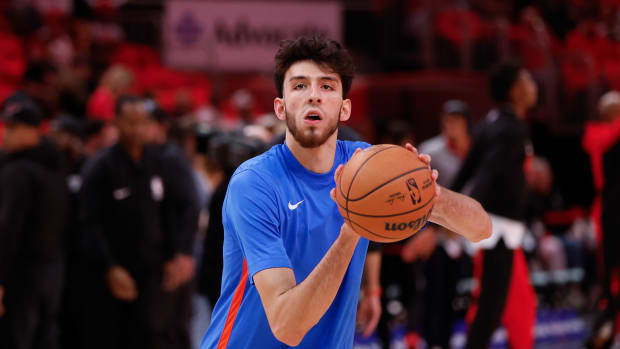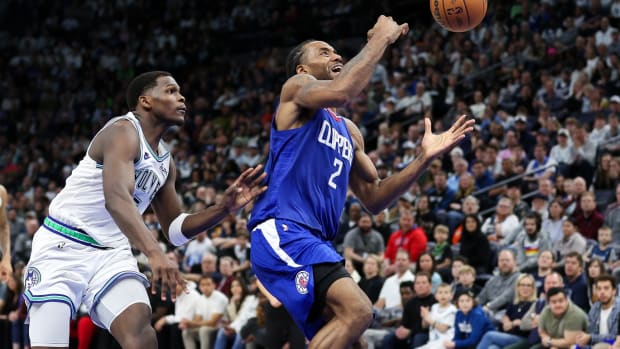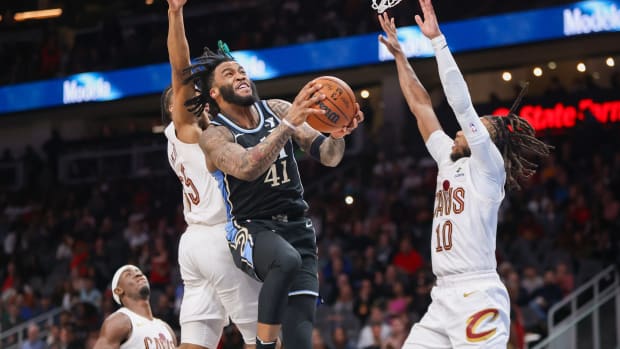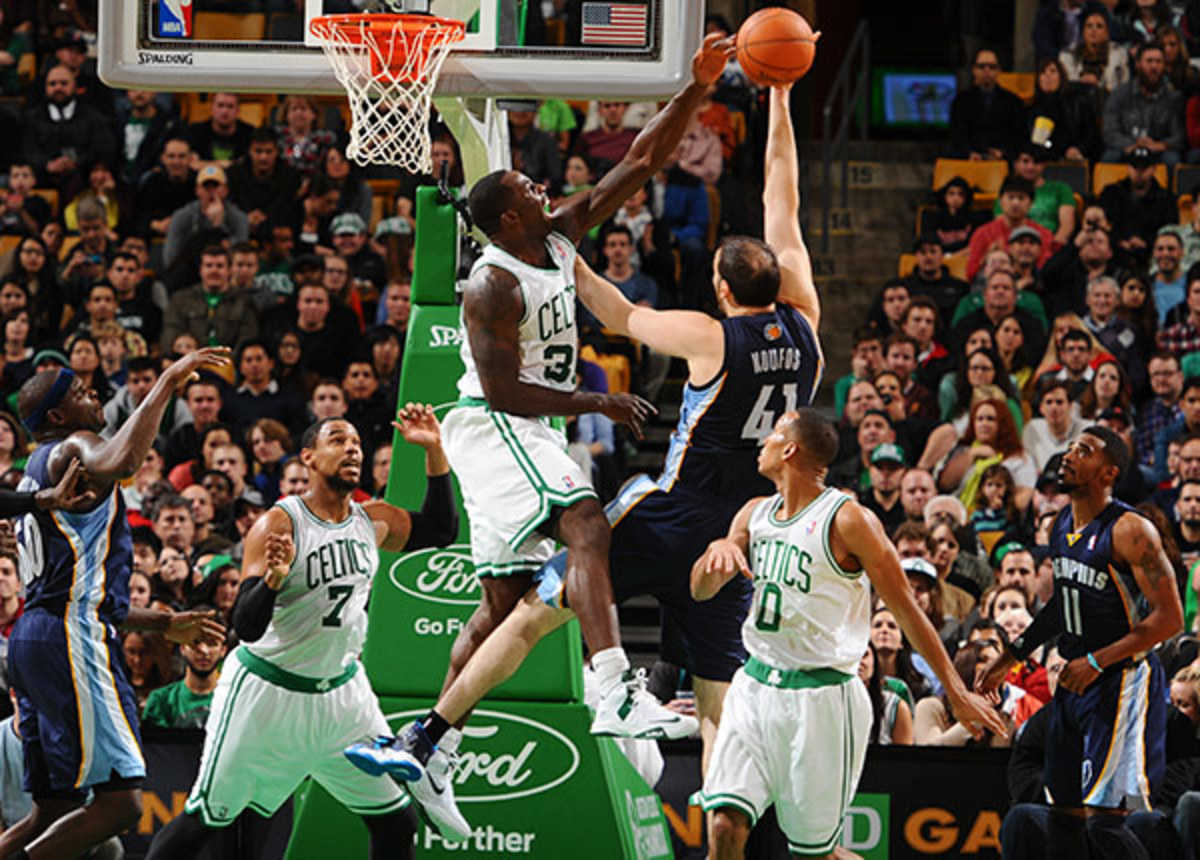
The Fundamentals: Brad Stevens' tenure with Celtics off to scrappy, stifling start
The 10-12 Celtics rank in the top 10 in points allowed per possession. (Brian Babineau/NBAE via Getty Images)
Celtics coach Brad Stevens is no stranger to the exceptional. In the NCAA realm of powerhouse schools and bulk recruiting, he took a steady path in making Butler basketball a presence. His team was the mid-major that could -- a two-time national runner-up, once as a No. 5 seed and once as a No. 8. He embraced every advantage he could find in a subset of the coaching industry that is notoriously old-fashioned, and made Drew Cannon the first full-time, analytics-driven hire to a college coaching staff. After all that, Stevens blindsided the basketball world when he agreed to step away from the groundwork he had built at Butler for a lengthy, substantial arrangement to coach the Celtics.
Breaking expectation, in a way, is simply what Stevens does.
That should at least mute some of the surprise in response to Stevens' positive turn in the NBA, where he's guided a partially deconstructed (and initially listless) Celtics roster to an Atlantic Division-leading 10-12 record. Many of Stevens' coaching peers have tried to make this exact jump in the past, from leader of college kids to motivator of highly talented and well-compensated professionals. Their stories are largely told in snickers; Rick Pitino is a punchline in Boston, where he took the Celtics to four straight losing seasons; John Calipari had a forgettable run with the Nets in the late 1990s; Mike Montgomery didn't get much out of the Warriors in two straight 34-win seasons in the mid-2000s. The tales of their failure serve as warning to all who consider the same path, and yet they didn't deter Stevens or impede his early progress.
To call Stevens' transition "seamless" would understate both his diligence and his team's early flaws. The seams are there -- Stevens has just worked relentlessly to keep them from showing. That patchwork effort begins on the defensive end, where after a rough start Stevens has pushed his team into the top 10 in points allowed per possession in a crowning achievement in scrap and scramble. Most of Boston's big men are undersized, its starting point guard is a defensive liability and nowhere to be found is the kind of transformational defender you'd expect of a top-10 unit. But Stevens and the Celtics make it work, through a smart system and improved focus throughout the roster.
DOLLINGER: Celtics rise to No. 16 in Power Rankings
It took a minute for the players to click into a new system from a new voice, but in a little more than a month Celtics forward Gerald Wallace has gone from hammering his teammates for their lack of effort to declaring that Boston is playing "almost perfect" basketball. That's a hilarious overreach, but it's a testament all the same to the way the Celtics have pulled together their defense.
They've done so by locking down the perimeter with incredible success, as Boston has prioritized its defense of the three-point line. When beyond the arc, Celtics defenders play tight to their marks, almost to a degree that would encourage driving. When the ball swings to an open opponent, a Boston player sprints out to chase him inside the arc. Everything is geared toward forcing shooters to compromise, and as a result the Celtics allow the fewest number of three-point attempts in the league (just 16.5 per game) at the second-worst percentage. Plus, forcing shooters to put the ball on the floor has created turnovers from a possession type that's normally as safe as they come. The catch-and-shoot three-pointer is an incredibly low-risk opportunity, but the Celtics have forced turnovers on 7 percent of their opponents' spot-up possessions, according to Synergy Sports. That's an impressive mark, on par with the three-point-conscious defenses in Indiana and Miami.
With such consistent pressure applied on the perimeter, Boston funnels opponents inward. Only six teams allow more field-goal attempts in the restricted area per game, but the Celtics compensate for that provision by contesting those attempts wonderfully. One wouldn't think that Jared Sullinger, Brandon Bass and undrafted rookie Vitor Faverani could form such a capable trio of help defenders, but the Celtics' second line of defense has been so punctual in its rotations and so effective in its contests as to make this strategic arrangement altogether manageable. That's what fundamentally separates Boston from a team like Detroit; Sullinger and Bass may lack the size of Greg Monroe and Andre Drummond, but they do a dramatically better job of positioning themselves against opposing drives.
GOLLIVER: Handing out team grades for the Rudy Gay trade
The same is true of the Celtics' work in guarding the pick-and-roll. The basic defensive structure in place isn't too different from what you'll find in Indiana, which makes sense given that Stevens has picked the brain of Pacers coach Frank Vogel. Celtics big men will guard the pick-and-roll by laying back to the free-throw line, containing the ball handler in a low-efficiency pocket until the screened guard can recover. Sullinger is especially successful in that regard. He's not especially big or quick, but by taking smart angles, Sullinger appears to cover more ground than he does. He's always in the way, whether in keeping a ball handler from getting to the rim or bumping a roll man off his path.
It helps, too, that Jeff Green and Wallace are able to step in from the perimeter to leave the basket better protected. On this play, Green strays from the Grizzlies' Tayshaun Prince -- an unthreatening 21 percent shooter from beyond the arc -- by design to delay Zach Randolph in the pick-and-roll:
Note: With these interactive still shots, hover over the target icons to view the relevant explanation as captions. To watch the full video of the play, click the overlaying play button.
Wallace tends to be a bit better with this kind of action than Green, who can be caught by a pass to his mark before he has a chance to recover. But as long as he closes out quickly to scare his opponent inside the three-point line, the principles of Boston's defense remain intact: The high-percentage shot will have been averted and the help will still be in place. From there, it's up to Sullinger, Bass and Faverani to protect the paint and the basket, an area in which all three have proved solid.
COURT VISION: Kobe draws mixed reviews in return
Opponents, though, don't seem particularly hip to that fact. You'll often see Celtics foes try to post up the squatty Sullinger, disregarding that he pushes bigger opponents off their spot with regularity and forces tough scoring angles inside. Some will try to sneak an attempt by Faverani around the rim, too, seemingly unaware that he's been one of the better shot-blockers in the NBA (2.4 blocks per 36 minutes). There's an element of surprise to the way that Boston's bigs have held things down in the lane, which should only make the Celtics all the more fascinating in the long game. Competent though they may be, players like Sullinger, Bass and Faverani are not beyond exploiting; there are ways around and over the help they provide. But it's up to Stevens and the Celtics to adjust when that time comes, and to find ways to further minimize defensive risk from entirely different angles.
Stevens has succeeded in his primary challenge of installing a system. If you watch closely, you can even catch notorious defensive spoil Jordan Crawfordpre-rotating at times. That's a problem all its own, but the fact that a coach could hammer a scheme into Crawford's head to the point that he would be ahead of schedule on his rotation is a miracle in itself.
It's from that foundation that Stevens has given a broken team something with which to work. Many of these Celtics will be gone by the time the team looks to rebuild in earnest, whether shipped out to save money or merely replaced by more qualified rotation players. But in their current form, they seem to have taken to the instruction of their fresh-faced rookie coach to a degree that can subsidize a near-.500 record.
NEXT PAGE: Kyrie Irving's poor shooting, the next step for Jeremy Lamb, the grace of Boris Diaw's spin move and more.
GO FIGURE
After two seasons of respectable shooting, Kyrie Irving's percentages have plummeted. (Kevin C. Cox/Getty Images)
• Much has been made -- in these parts, among others -- of Rudy Gay's miserable combination of high-volume shooting and horrid inefficiency, crystallized in his statistical line as 38.8 percent shooting on 18.6 field-goal attempts per game. That terrible combination served as a legitimate drain on the Raptors' offense despite his scoring total.
Meanwhile, the Cavaliers have been even more disappointing this season, with Kyrie Irving providing nearly as much offensive dead weight. At numbers just a bit shy of Gay's shooting percentage (39.4 percent) and volume (18.6), doesn't Irving's crummy start at least warrant mention in the same breath, no matter his shinier reputation?
• A round of applause is in order for Orlando's Victor Oladipo, who finally slid out of first place in turnovers per game by averaging only three over his last four. There is no purer form of trial and error than an athletic rookie guard given freedom to work.
On the same beat, James Harden (4.0), Russell Westbrook (3.9), Stephen Curry (3.8) and LeBron James (3.8) are your new established leaders, though Kobe Bryant (with eight turnovers in his season debut) announced his entry with authority.
• Kings center DeMarcus Cousins has the distinct honor of leading the league in fouls per game while sharing the lead for technical fouls. With a few flagrants, he could really make a run at the triple crown.
NOTES FROM AROUND THE ASSOCIATION
It's been a tough start to the season for Vince Carter, who hasn't yet adapted to his modified role with the Mavs. (Layne Murdoch/NBAE via Getty Images)
1. A valuable contributor fades in Dallas
Even without suffering another injury, the Mavs have taken a hit to their depth chart with Vince Carter's struggles. Last season, Carter was an invaluable resource in Dirk Nowitzki's absence and a successful complement upon his return. He was an effective (if trigger-happy) ball handler for a team that desperately needed one. He was the Mavs' most prolific three-point threat, converting a team-high 4.9 attempts at a 40 percent clip. He picked up challenging defensive assignments to save Shawn Marion's legs, ran pick-and-rolls to save O.J. Mayo the trouble and averaged nearly twice as many assists as he did turnovers.
JOHNSON: Michael Beasley finding niche in Miami
He was pretty close to a form-fitting, gap-filling role player as you're likely to find at his price point ($3.2 million this season), and was expected to provide more of the same for a far better equipped Dallas team this season. Unfortunately, Carter's play has dipped virtually across the board, including 37.3 percent shooting from the field. That Carter is no stranger to forcing up difficult shots make his shooting woes even tougher to stomach, particularly when the arrival of Monta Ellis and Jose Calderon should be making his work on offense come easier.
Get right, Vince -- the Mavs are more fun with you in finer form.
2. The next step for Jeremy Lamb
It's good to see the second-year guard making good on a bigger role with the Thunder, and he's already emerged as a reliable spot-up option from three-point range. Where he struggles a bit, though, is in translating that shooting touch when forced to take a step in. Take a look at Lamb's shot chart for the season, courtesy of NBA.com:
Notice that swath of red just inside the three-point line? That's prime territory for a step-in jumper, which can be a problematic shot for standstill shooters. Lamb does well to convert his catch-and-shoot opportunities when stationary, but he tends to lose his shooting consistency when taking that one-dribble pull-up. It's a valuable skill for a shooter as quick on his feet as Lamb, and the kind of minor development that could make him a more potent kick-out option.
3. Marcin Gortat is a different kind of stretch big
The Wizards' Gortat has succeeded in the pick-and-roll at each of his three NBA stops. Playing with point guard John Wall this season, the 6-11 Gortat has converted an outstanding 65.5 percent of his pick-and-roll finishes. Gortat is very mobile for his size, which allows him to navigate the lane easily; his balance on the pick-and-roll is terrific, allowing him to change directions or stop on a dime if need be; and he has a soft touch with both hands, allowing him to work in either direction.
Yet beyond all that, Gortat seems particularly enabled by his ability to extend horizontally in the pick-and-roll. Rarely do you see a pick-and-roll finisher stretch for finishes around the basket from such distances, in part because few have the one-handed ball security and ability to convert layups that Gortat does. Those monster mitts allow Gortat to maneuver his release point through a crowd, even when his path to the rim would seem closed. It's a hell of a thing, setting Gortat apart from even other finesse finishers.
4. Dance of the Hours by Boris Diaw
I don't know what it says about me that when I see this, I think of this.
5. Reconsidering McBob as a Bobcat
At the time, Charlotte's two-year, $5.5 million signing of Josh McRoberts seemed one of the blander contracts of the summer -- a fair deal for a fair player. But through 20 games, McRoberts has proved to be a very necessary piece for the Bobcats and a deserving starter ahead of Cody Zeller.
CODY ZELLER: Life as an NBA rookie
At times, McRoberts' presence has served as the difference between Charlotte's offense being merely and downright terrible. The primary reason? McRoberts' dynamism compared to that of Charlotte's more limited big men, whether through his bits of shooting, his work off the ball or his committed passing on a team with few quality playmakers. For all his limitations, McRoberts ranks second on the team in three-point makes and first in assists per minute. Those rankings may indicate that something is very wrong with the Bobcats' construction, but they also highlight McRoberts' usefulness to this particular team.
Statistical support for this post provided by NBA.com.


































